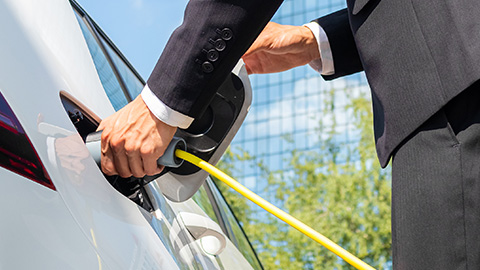
Patents portfolio
Innovation spans the entire Geotab ecosystem and many fundamental building blocks of the Geotab platform.
Protecting Geotab's innovative intellectual property
One external indicator of a company’s ability to provide new and useful innovations is a patent granted by a governmental agency. Other external indicators include the range of patented technology and the historical track record of the company over time. The United States Patent and Trademark Office (USPTO) is one example of a governmental agency that has granted many patents to Geotab. The European Patent Office (EPO) is another example of a governmental agency that has granted many patents in many European countries to Geotab. The Geotab patents cover many different aspects of the Geotab ecosystem, including: algorithms, Geotab GO device technology, MyGeotab fleet management software technology, Geotab Input Output expansion technology and business analytics.
Geotab's Patents
Click on a category below to view patents
All
Aspects Of A Configurable Intelligent I/O Expander System (US 9,128,867)
Peripheral expansion of the Geotab Platform to include other Market Place devices and technology is an important capability of the Geotab telematics system. An important consideration for peripheral expansion is to have a technological design that will accommodate many different future unknown devices. This innovative algorithm provides an automatic detection and identification of the unknown class of peripheral with a corresponding initialization to set the form of communication and mode of control for the peripheral.
Aspects Of A Mobile Device Protocol Health Monitoring System (US 10,098,025)
Communication between a Geotab GO device and a vehicle bus permits monitoring and logging vehicle data. One of the challenges this form of communication is interference that impedes or disrupts communication between the GO device and the vehicle bus preventing monitoring and logging of vehicle data. This innovative Geotab technology provides an algorithm to monitor communication message transmission rates and establish thresholds to monitor and avoid interference that impedes or disrupts the communication.
Aspects Of An Aperiodic Nonrandom Trigger for Vehicular Telematics Data Queries (US 8,706,348)
An onboard telematics device must be efficient both in terms of battery power consumption when a vehicle is not operational and when communicating data. Some of the challenges for efficient operation of the device are minimizing power consumption, becoming operational and communicating only when necessary. This innovative solution provides an onboard device with both a resource conserving state and a fully operational state. The onboard device minimizes power consumption and communication by smart switching to the fully operational state based upon sensing select vehicle operational conditions with a hierarchy of trigger thresholds.
Aspects Of An Event Driven Data Acquisition Switch (US 8,688,380)
Minimizing the size of data communication packets in a telematics system avoids excess communication expense for customers. However, there are certain situations, such as an accident, where communication of more detailed data is required for post accident analysis. This Geotab innovation provides a low frequency data acquisition mode and a high frequency data acquisition mode based upon an accelerometer threshold value indicative of harsh events or an accident. The low frequency state avoids communication expense while the high frequency state provides much more detail when required based upon a particular event.
Aspects Of An Intelligent Bluetooth Beacon I/O Expansion System (EP 2,125,579)
Commercial vehicles may include a minimum equipment list to be available with the vehicle. This equipment may also be subject to certain operational conditions to avoid damage. Transportation of packages and goods with a commercial vehicle may be sensitive and prone to damage. Identifying and tracking equipment, packages and goods to monitor their presence or absence with a vehicle and normal or out of normal conditions that may result in damage can be valuable to fleet management. This innovative Geotab technology provides an ability to monitor and track Bluetooth beacons associated with a vehicle, equipment, packages and goods. The Bluetooth beacons can provide data associated with acceleration, temperature, light, pressure and other parameters. This data can be processed to determine harsh conditions, hazardous conditions or out of limit conditions.
Aspects Of A Reversing Vehicle Remote Telematics Detection System (US 8,744,700)
Accident detection and operational use of a vehicle in reverse are important feature of a telematics system. One of the challenges for accurate identification of a reverse operation of a vehicle relates to the anti locking braking system (ABS) that may actually interfere with sensing and detecting a reverse operation. This innovative solution provides a system that uses both a vehicle speed threshold and an accelerometer threshold to accurately detect and report a reverse operation of the vehicle.
Aspects Of A System For Optimally Recording Geographical Position Data Summary (US 8,032,276)
Minimizing the size of data communication packets in a telematics system avoids excess communication expense for customers. One of the challenges is providing enough detail in the positional data of a vehicle to satisfy the needs of a business and the customers while avoiding the expense of data communication. This innovation provides a solution to the challenge in a device by logging select vehicle positional data based upon time and changing position thresholds or limits.
Aspects Of A Telematics Furtherance Visualization System (US 10,051,432)
Accurate representations of a moving vehicle on a computerized display is an important capability of a telematics system. Optimized communication of telematics data is also important for managing telecommunication expenses. Some of the challenges to overcome were positional errors as well as inconsistent erratic representations of the moving vehicle on a computerized display due to the optimized communication of the data. This Geotab innovative technology includes a pair of distributed processes. A first distributed process reconciles the difference between the actual path of the vehicle and the virtual path of the vehicle. A second distributed process provides an adaptive render to accurately provide a graphical image of a vehicle on a computerized map.
Aspects Of A Telematics Furtherance Visualization System (US 9,538,334)
Accurate representations of a moving vehicle on a computerized display is an important capability of a telematics system. Optimized communication of telematics data is also important for managing telecommunication expenses. Some of the challenges to overcome were positional errors as well as inconsistent erratic representations of the moving vehicle on a computerized display due to the optimized communication of the data. This Geotab innovative technology provides accurate representations of a moving vehicle with optimized communication of data using proprietary alignment algorithms with a capability to sense and correct potential misalignments through a calibrated adaptive render of the moving vehicle on a computerized display.
Aspects Of A Telematics Furtherance Visualization System (US 9,913,101)
Accurate representations of a moving vehicle on a computerized display is an important capability of a telematics system. Optimized communication of telematics data is also important for managing telecommunication expenses. Some of the challenges to overcome were positional errors as well as inconsistent erratic representations of the moving vehicle on a computerized display due to the optimized communication of the data. This Geotab innovative technology includes a pair of distributed processes. A first distributed process in a mobile device reconciles the difference between the actual path of the vehicle and the virtual path of the vehicle. A second distributed process, remote from the mobile device, provides an adaptive render to accurately provide a graphical image of a vehicle on a computerized map.
Aspects Of A VIN Based Accelerometer Threshold (US 9,607,444)
Accelerometers provide an important capability to any telematics system. The accelerometer data may be used to identify situations of harsh operation of a vehicle such as acceleration, braking, cornering and indications of an accident. One of the challenges is determining an appropriate accelerometer threshold for the many different types and configurations of vehicles. This Geotab innovation receives, decodes and analyzes a vehicle identification number (VIN) to determine the particular makeup, configuration and options associated with the vehicle establish an appropriate accelerometer threshold for a particular vehicle.
Aspects Of A Big Data Constructing System (US 10,074,220)
Telematics data can enable deeper business insights from business analytics. Raw telematics data requires a transformation into one or more formats to enable subsequent business analytic queries or analytical processing. Some of the challenges to transform the raw telematics data include the timing of resource availability, scaling, the complexity of the data loads and balancing the data loads. This innovative Geotab technology provides a system to separate out streams of raw telematics data into categories of data to scale and balance data loads and resource availability. One category of data is preserved without any transformation. A second category of data is alter data where the alter data may be transformed as augmented and supplemented data. An example of augmented data is transforming latitude and longitude coordinates into a street name or a street address. An example of supplemented data is transforming vehicle specific data into a vehicle speed or an engine RPM.
Aspects Of A Configurable Intelligent I/O Expander System (US 8,918,547)
Providing an open platform permits expansion of the Geotab ecosystem and increases value through the addition of Marketplace devices and technology. One of the challenges such an expansion creates is the ability to communicate throughout the entire system with many different complex technologies. This Geotab innovation provides a system with an I/OX that self configures a multi-device interface with different devices and technology connected to the interface. This innovation further establishes a communication protocol in the system as either an active direct communication or an indirect passive communication between different components and devices in the system.
Aspects Of A Configurable Intelligent I/O Expander System (US 9,122,621)
Communication between a Geotab GO device, a Geotab I/OX and the MyGeotab software with associated MarketPlace devices and technology provides expansion of the Geotab ecosystem. This innovative Geotab technology establishes the operational mode of control for a peripheral and subsequent communication between different computing technologies after automatic detection and identification of each unknown class of associated peripheral technology.
Aspects Of An Intelligent Bluetooth Beacon I/O Expansion System (EP 2,125,579)
Commercial vehicles may include a minimum equipment list to be available with the vehicle. This equipment may also be subject to certain operational conditions to avoid damage. Transportation of packages and goods with a commercial vehicle may be sensitive and prone to damage. Identifying and tracking equipment, packages and goods to monitor their presence or absence with a vehicle and normal or out of normal conditions that may result in damage can be valuable to fleet management. This innovative Geotab technology provides an ability to monitor and track Bluetooth beacons associated with a vehicle, equipment, packages and goods. The Bluetooth beacons can provide data associated with acceleration, temperature, light, pressure and other parameters. This data can be processed to determine harsh conditions, hazardous conditions or out of limit conditions.
Aspects Of A Configurable Intelligent I/O Expander System (US 8,918,547)
Providing an open platform permits expansion of the Geotab ecosystem and increases value through the addition of Marketplace devices and technology. One of the challenges such an expansion creates is the ability to communicate throughout the entire system with many different complex technologies. This Geotab innovation provides a system with an I/OX that self configures a multi-device interface with different devices and technology connected to the interface. This innovation further establishes a communication protocol in the system as either an active direct communication or an indirect passive communication between different components and devices in the system.
Aspects Of A Configurable Intelligent I/O Expander System (US 9,122,621)
Communication between a Geotab GO device, a Geotab I/OX and the MyGeotab software with associated MarketPlace devices and technology provides expansion of the Geotab ecosystem. This innovative Geotab technology establishes the operational mode of control for a peripheral and subsequent communication between different computing technologies after automatic detection and identification of each unknown class of associated peripheral technology.
Aspects Of An Aperiodic Nonrandom Trigger for Vehicular Telematics Data Queries (US 8,706,348)
An onboard telematics device must be efficient both in terms of battery power consumption when a vehicle is not operational and when communicating data. Some of the challenges for efficient operation of the device are minimizing power consumption, becoming operational and communicating only when necessary. This innovative solution provides an onboard device with both a resource conserving state and a fully operational state. The onboard device minimizes power consumption and communication by smart switching to the fully operational state based upon sensing select vehicle operational conditions with a hierarchy of trigger thresholds.
Aspects Of An Event Driven Data Acquisition Switch (US 8,688,380)
Minimizing the size of data communication packets in a telematics system avoids excess communication expense for customers. However, there are certain situations, such as an accident, where communication of more detailed data is required for post accident analysis. This Geotab innovation provides a low frequency data acquisition mode and a high frequency data acquisition mode based upon an accelerometer threshold value indicative of harsh events or an accident. The low frequency state avoids communication expense while the high frequency state provides much more detail when required based upon a particular event.
Aspects Of A Reversing Vehicle Remote Telematics Detection System (US 8,744,700)
Accident detection and operational use of a vehicle in reverse are important feature of a telematics system. One of the challenges for accurate identification of a reverse operation of a vehicle relates to the anti locking braking system (ABS) that may actually interfere with sensing and detecting a reverse operation. This innovative solution provides a system that uses both a vehicle speed threshold and an accelerometer threshold to accurately detect and report a reverse operation of the vehicle.
Aspects Of A Substitute Flange Sleeve For Alternative Mounting Of A Cylindrical Heavy Duty Deutsch Type On-Board Diagnostic Receptacle (US 10,033,130)
A telematics device interfaces to a vehicle through a physical diagnostic cable interface. One of the challenges is that the physical vehicle diagnostic cable interfaces are not standardized and are different from manufacturer to manufacturer. This Geotab technology provides a single cable mounting sleeve that is adaptable to many different manufacturer physical vehicle diagnostic cable interfaces providing a universal cable to connect a telematics device.
Aspects Of A System For Optimally Recording Geographical Position Data Summary (US 8,032,276)
Minimizing the size of data communication packets in a telematics system avoids excess communication expense for customers. One of the challenges is providing enough detail in the positional data of a vehicle to satisfy the needs of a business and the customers while avoiding the expense of data communication. This innovation provides a solution to the challenge in a device by logging select vehicle positional data based upon time and changing position thresholds or limits.
Aspects Of A Telematics Furtherance Visualization System (US 9,538,334)
Accurate representations of a moving vehicle on a computerized display is an important capability of a telematics system. Optimized communication of telematics data is also important for managing telecommunication expenses. Some of the challenges to overcome were positional errors as well as inconsistent erratic representations of the moving vehicle on a computerized display due to the optimized communication of the data. This Geotab innovative technology provides accurate representations of a moving vehicle with optimized communication of data using proprietary alignment algorithms with a capability to sense and correct potential misalignments through a calibrated adaptive render of the moving vehicle on a computerized display.
Aspects Of A VIN Based Accelerometer Threshold (US 8,977,426)
Accelerometers provide an important capability to any telematics system. The accelerometer data may be used to identify situations of harsh operation of a vehicle such as acceleration, braking, cornering and indications of an accident. Appropriate accelerometer thresholds are therefore key to providing accurate indications of harsh operation or a vehicle accident. This Geotab innovation receives, decodes and analyzes a vehicle identification number (VIN) to determine the particular makeup, configuration and options associated with the vehicle. Then, a vehicle specific weight is determined to calculate and establish a better set of accelerometer thresholds based upon each unique vehicle.
Aspects Of A Big Data Constructing System (US 10,074,220)
Telematics data can enable deeper business insights from business analytics. Raw telematics data requires a transformation into one or more formats to enable subsequent business analytic queries or analytical processing. Some of the challenges to transform the raw telematics data include the timing of resource availability, scaling, the complexity of the data loads and balancing the data loads. This innovative Geotab technology provides a system to separate out streams of raw telematics data into categories of data to scale and balance data loads and resource availability. One category of data is preserved without any transformation. A second category of data is alter data where the alter data may be transformed as augmented and supplemented data. An example of augmented data is transforming latitude and longitude coordinates into a street name or a street address. An example of supplemented data is transforming vehicle specific data into a vehicle speed or an engine RPM.
Aspects Of A Configurable Intelligent I/O Expander System (EP 2,657,848)
Communication between a Geotab GO device, a Geotab I/OX and the MyGeotab software with associated MarketPlace devices and other technology and devices provides an ability to monitor and log many different types of data. This innovative Geotab technology provides a system to expand a Geotab GO device for communicating and logging data from additional peripheral technology and devices. An active mode is available for peripheral technology and devices to directly monitor and log data. A passive mode is also available for peripheral technology and devices that have a control capability.
Aspects Of A Configurable Intelligent I/O Expander System (US 8,918,547)
Providing an open platform permits expansion of the Geotab ecosystem and increases value through the addition of Marketplace devices and technology. One of the challenges such an expansion creates is the ability to communicate throughout the entire system with many different complex technologies. This Geotab innovation provides a system with an I/OX that self configures a multi-device interface with different devices and technology connected to the interface. This innovation further establishes a communication protocol in the system as either an active direct communication or an indirect passive communication between different components and devices in the system.
Aspects Of An Aperiodic Nonrandom Trigger for Vehicular Telematics Data Queries (US 8,706,348)
An onboard telematics device must be efficient both in terms of battery power consumption when a vehicle is not operational and when communicating data. Some of the challenges for efficient operation of the device are minimizing power consumption, becoming operational and communicating only when necessary. This innovative solution provides an onboard device with both a resource conserving state and a fully operational state. The onboard device minimizes power consumption and communication by smart switching to the fully operational state based upon sensing select vehicle operational conditions with a hierarchy of trigger thresholds.
Aspects Of An Event Driven Data Acquisition Switch (US 8,688,380)
Minimizing the size of data communication packets in a telematics system avoids excess communication expense for customers. However, there are certain situations, such as an accident, where communication of more detailed data is required for post accident analysis. This Geotab innovation provides a low frequency data acquisition mode and a high frequency data acquisition mode based upon an accelerometer threshold value indicative of harsh events or an accident. The low frequency state avoids communication expense while the high frequency state provides much more detail when required based upon a particular event.
Aspects Of A Reversing Vehicle Remote Telematics Detection System (US 8,744,700)
Accident detection and operational use of a vehicle in reverse are important feature of a telematics system. One of the challenges for accurate identification of a reverse operation of a vehicle relates to the anti locking braking system (ABS) that may actually interfere with sensing and detecting a reverse operation. This innovative solution provides a system that uses both a vehicle speed threshold and an accelerometer threshold to accurately detect and report a reverse operation of the vehicle.
Aspects Of A System For Optimally Recording Geographical Position Data (US 8,670,928)
Minimizing the size of data communication packets in a telematics system avoids excess communication expense for customers. One of the challenges is providing enough detail in the positional data of a vehicle to satisfy the needs of a business and the customers while avoiding the expense of data communication. This innovation provides a solution to the challenge in a system by logging select vehicle positional data based upon time and changing position thresholds or limits.
Aspects Of A Telematics Furtherance Visualization System (US 10,051,432)
Accurate representations of a moving vehicle on a computerized display is an important capability of a telematics system. Optimized communication of telematics data is also important for managing telecommunication expenses. Some of the challenges to overcome were positional errors as well as inconsistent erratic representations of the moving vehicle on a computerized display due to the optimized communication of the data. This Geotab innovative technology includes a pair of distributed processes. A first distributed process reconciles the difference between the actual path of the vehicle and the virtual path of the vehicle. A second distributed process provides an adaptive render to accurately provide a graphical image of a vehicle on a computerized map.
Aspects Of A Telematics Furtherance Visualization System (US 9,913,101)
Accurate representations of a moving vehicle on a computerized display is an important capability of a telematics system. Optimized communication of telematics data is also important for managing telecommunication expenses. Some of the challenges to overcome were positional errors as well as inconsistent erratic representations of the moving vehicle on a computerized display due to the optimized communication of the data. This Geotab innovative technology includes a pair of distributed processes. A first distributed process in a mobile device reconciles the difference between the actual path of the vehicle and the virtual path of the vehicle. A second distributed process, remote from the mobile device, provides an adaptive render to accurately provide a graphical image of a vehicle on a computerized map.
Aspects Of A VIN Based Accelerometer Threshold (US 8,977,426)
Accelerometers provide an important capability to any telematics system. The accelerometer data may be used to identify situations of harsh operation of a vehicle such as acceleration, braking, cornering and indications of an accident. Appropriate accelerometer thresholds are therefore key to providing accurate indications of harsh operation or a vehicle accident. This Geotab innovation receives, decodes and analyzes a vehicle identification number (VIN) to determine the particular makeup, configuration and options associated with the vehicle. Then, a vehicle specific weight is determined to calculate and establish a better set of accelerometer thresholds based upon each unique vehicle.
Have a question regarding one of our patents?
Reach out to our support team for additional information.





